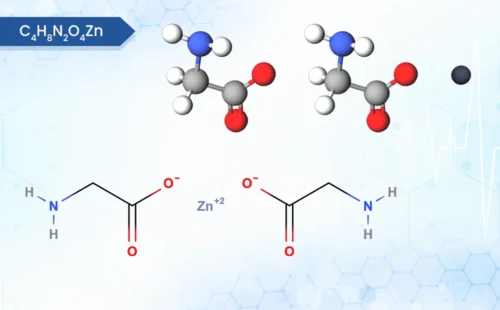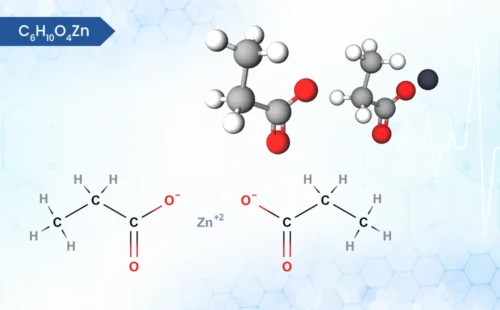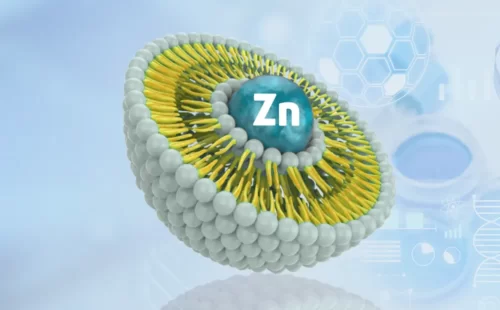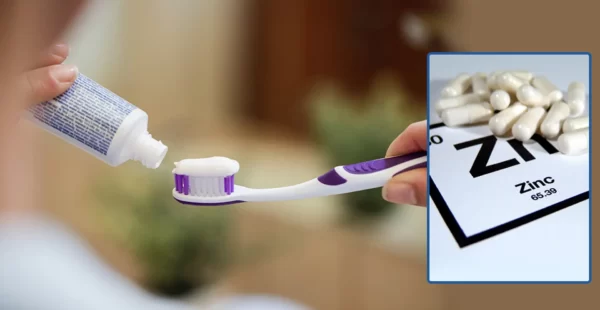-
Product Name:
Zinc Citrate
-
Molecular Formula:
C12H10O14Zn3
-
Molecular Weight:
574.3 g/mol
-
CAS No.:
5990-32-9
-
HSN Code:
29181590
-
CID Code:
11023
-
Shelf Life:
3 years - 20°C powder
-
DrugBank ID
DB11154
-
ChemSpider ID
10557
-
UNII No.
K72I3DEX9B
- USP
- IUPAC Names
- Synonyms
- MSDS
USP of Zinc Citrate
- Zinc is essential for cell growth and division, immune function, enzyme reactions etc.
- Zinc citrate is used in toothpaste and mouth wash as It helps freshen breath by reducing the impact of odorous compounds produced in our mouth by bacteria.
IUPAC Names of Zinc Citrate
trizinc;2-hydroxypropane-1,2,3-tricarboxylate
Synonyms of Zinc Citrate
- Zinc citrate
- 546-46-3
- Trizinc dicitrate
- Citric acid, zinc salt
- K72I3DEX9B
- UNII-K72I3DEX9B
- trizinc 2-hydroxypropane-1,2,3-tricarboxylate
- 1,2,3-Propanetricarboxylic acid, 2-hydroxy-, zinc salt (2:3)
- 2-Hydroxy-1,2,3-propanetricarboxylic acid zinc salt
- trizinc;2-hydroxypropane-1,2,3-tricarboxylate
- trizinc 2-oxidanylpropane-1,2,3-tricarboxylate
- 2-Hydroxy-1,2,3-propanetricarboxylic acid, zinc salt
MSDS of Zinc Citrate
Download MSDS PDF- Inhalation: Move exposed person to fresh air. If not breathing, seek immediate medical attention. If breathing is irregular or if respiratory arrest occurs, provide artificial respiration or oxygen by trained personnel and seek medical attention.
- Ingestion: Do not induce vomiting unless directed to do so by medical personnel. Never give anything by mouth to an unconscious person. Seek medical attention.
- Skin Contact: Remove contaminated clothing and shoes and immediately flush skin with plenty of water for at least 15 minutes. Wash clothing before reuse. Clean shoes thoroughly before reuse. If irritation persists, seek medical attention.
- Eye Contact: Check for and remove any contact lenses. Immediately flush eyes with plenty of water for at least 15 minutes, occasionally lifting the upper and lower eyelids. Seek immediate medical attention.
- Flammability of the Product: May be combustible at high temperature.
- Auto-Ignition Temperature: Not available.
- Flash Points: Not available.
- Flammable Limits: These products are carbon oxides (CO, CO2), nitrogen oxides (NO, NO2…). Some metallic oxides.
- Products of Combustion: Slightly flammable to flammable in presence of heat. Non-flammable in presence of shocks.
- Fire Hazards in Presence of Various Substances: Slightly explosive in presence of open flames and sparks. Non-explosive in presence of shocks.
- Fire Fighting Media and Instructions:
SMALL FIRE: Use DRY chemical powder.
LARGE FIRE: Use water spray, fog or foam. Do not use water jet. - Special Remarks on Fire Hazards: Fire is possible at elevated temperatures.
- Special Remarks on Explosion Hazards: Fine dust dispersed in air in sufficient concentrations, and in the presences of an ignition source is a potential dust explosion hazard.
- Engineering Controls: Use process enclosures, local exhaust ventilation, or other engineering controls to keep airborne levels below Recommended exposure limits. If user operations generate dust, fume or mist, use ventilation to keep exposure to airborne contaminants below the exposure limit.
- Personal Protection: Safety glasses. Lab coat. Dust respirator. Be sure to use an approved/certified respirator or equivalent. Gloves.
- Personal Protection in Case of a Large Spill: Splash goggles. Full suit. Dust respirator. Boots. Gloves. A self-contained breathing apparatus should be used to avoid inhalation of the product. Suggested protective clothing might not be sufficient; consult a specialist BEFORE handling this product.
- Exposure Limits: Not available.
- pH (of 3% w/v aqueous suspension): No data available
- Melting point/freezing point: No data available
- Initial boiling point and boiling range: No data available
- Sublimation Temperature: No data available

Description of Zinc Citrate
Zinc citrate, a vital mineral supplement, boasts distinct physical and chemical properties. It typically appears as a white, odorless, crystalline powder with a slightly grainy texture. Unlike some minerals, zinc citrate is surprisingly hydrophilic, meaning it readily attracts and dissolves in water. This high solubility contributes to its excellent bioavailability, allowing the body to easily absorb the zinc it contains. From a scientific standpoint, zinc citrate is the zinc salt of citric acid, with the chemical formula C6H5O7Zn3.
Its molecular weight is around 471 g/mol, and it decomposes when heated above 200°C. This combination of physical and chemical characteristics makes zinc citrate a well-tolerated and effective form of zinc for dietary supplements and other applications. As a leading API manufacturer, WBCIL prioritizes strict CGMP and ISO quality control measures throughout the production process. The prolonged experience from 1962 ensures consistent potency, purity, and safety in every dose of WBCIL’s zinc citrate.
Application of Zinc Citrate
Pharmaceutical Industry
- Dietary Supplements: Commonly used in zinc supplements to help prevent zinc deficiency and support immune health.
- Cold Remedies: Included in products aimed at reducing the duration and severity of cold symptoms.
- Bone Health: Used in formulations to support bone health due to its role in collagen synthesis and bone mineralization.
Oral Care Products
- Toothpaste and Mouthwash: Utilized for its antibacterial properties, helping to reduce plaque formation, control bad breath, and prevent gingivitis.
- Tooth Whitening: Sometimes included in whitening toothpaste formulations to enhance dental health and appearance.


















